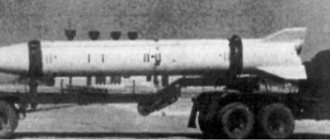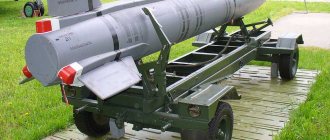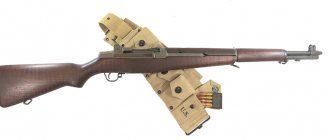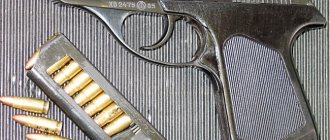P-36M (SS-18 Satan)
Soviet intercontinental missile with a maximum range of 16,000 km. 10 thermonuclear units can incinerate 10 individual targets, and an advanced system for overcoming missile defense will prevent enemy air defense systems from shooting down incoming warheads.
The missile's combat readiness time is 62 seconds. This means that just a minute after the start of preparation, the P-36M can fly out of the silo and punish anyone who has encroached on the integrity of the state.
The maximum speed of falling nuclear warheads is about 8 km/s. This real-life missile put an end to the arms race between the USSR and the USA. The US military was seriously concerned about the Soviets having such a formidable doomsday weapon.
The most interesting thing is that the engineers planned to equip the rocket with an even more formidable warhead. This is how it was planned to install a warhead with 38 thermonuclear blocks with a power of 250 kt each. A few of these missiles could decide the outcome of any war.
Peculiarities:
Range – 16,000 km
Hit accuracy – 220 m
Launch weight – 211 t
Combat equipment – 10 thermonuclear blocks with a power of 800 kt
The presence of an active missile defense system consisting of decoys, jammers and dipole reflectors
R-29RMU2 Sineva
Russian third generation ICBM. Adopted in 2007. The maximum flight range of 11,500 km makes it possible to hit almost any target. And if you consider that the missile is based on submarines, then it can be used to hit any target on the planet.
The carrier of the R-29RMU2 Sinev missile is the Project 667BDRM submarine “Dolphin”. The boat with two nuclear reactors carries 16 such missiles on board. Agree - a very formidable weapon.
The warhead contains several individually targetable nuclear warheads. The GLONASS system is used to control the flight of the rocket. Missiles can be launched from an underwater position from a depth of 55 meters.
Peculiarities:
Range – 11,500 km
Hit accuracy – 500 m
Launch weight – 40 t
Combat equipment - 10 individually targeted nuclear units with a power of 100 kt, or 4 units with a power of 500 kt
Availability of an active missile defense system
LGM-30G Minuteman III, USA – 10,000 km
- The LGM-30G Minuteman III has an estimated flight range of 6,000 kilometers to 10,000 kilometers, depending on the type of warhead. This missile entered service in 1970 and is the world's oldest missile in service. It is also the only silo-based missile in the United States.
- The first launch of the rocket took place in February 1961, modifications II and III were launched in 1964 and 1968, respectively.
- The rocket weighs about 34,473 kilograms and is equipped with three solid propellant engines. Rocket flight speed 24,140 km/h
DongFeng 5A
The longest-range Chinese ICBM. The maximum flight range is 13,000 km. This missile was developed to destroy particularly important targets in the United States. The missile entered service in 1993. An on-board computer and an inertial guidance system are used to control the ICBM.
The multiple warhead allows you to hit several important targets on enemy territory with an average accuracy of 1000 meters. According to some reports, the hit accuracy is higher and amounts to 500 m.
Currently, China has about 36 DongFeng 5A missiles in service. 13 of them are constantly aimed at the United States.
Peculiarities:
Range – 13,000 km
Hit accuracy – 1000 m (500 m)
Launch weight – 183 t
Combat equipment – 6 individually targeted nuclear units with a capacity of 350 kt
UGM-133A Trident II
American intercontinental ballistic missile with a range of 11,300 km. Based on the submarines Ohio (USA) and Vanguard (UK). The first rocket launches took place in 1987.
Thanks to the use of an advanced control and guidance unit, the maximum hit accuracy is an impressive 50 m. The high firing range, together with the sea-based missile, makes it a very formidable weapon. And 8 thermonuclear blocks with a power of 475 kt can easily destroy several particularly important enemy targets.
Peculiarities:
Range – 11,300 km
Hit accuracy - 90 m with GPS, 120 m with astro correction, 360 - 500 m inertial
Launch weight – 59 t
Combat equipment – 8 individually targeted thermonuclear units with a power of 475 kt
Advanced guidance system - inertial + astro correction + GPS
To the bottom
The idea of deploying ballistic missiles under water was born even before the first projects of submarine missile carriers. Finding a container with a rocket attached to the bottom in the middle of the ocean is no easier than finding a needle in a haystack. And when given a signal, it will calmly emerge and send the nuclear missile gift on its short journey. With the advent of rockets launching from under water, everything has become even simpler - there is no need to make a pop-up container. There were also projects of real underwater-underground missile bases. But they didn’t have time to implement any of this, and in the end they banned it.
Artist's representation of an underwater launch platform
Placing missiles underwater turned out to be too secretive to maintain a state of equilibrium. A new mine can be tracked; even a new submarine in the port is not a problem to detect. But it is difficult to determine how many such containers with missiles were found in the world’s oceans. This way, one of the sides can secretly create an advantage in means of attack and decide to attack. Economics also played a role - even more funds need to be raised to counter this method than to hunt for submarines. Finally, such a system would have to be completely autonomous, devoid of direct human control and programmed to respond to fairly simple commands (complex codes cannot be transmitted to great depth). And no one liked this categorically.
In order not to go twice, they banned such placement in their reservoirs, even launchers crawling along the bottom were banned - just in case they come up with such things.
Project of a pop-up container for Polaris missiles
M51
French intercontinental ballistic missile with a range of 10,000 km. France has the third largest nuclear arsenal after the United States and Russia.
The missile entered service in 2010 and is currently based on Triomphant-class submarines. A total of 16 launch silos for M51 missiles are installed on board the submarine. The head of each rocket can contain 4 thermonuclear blocks of 300 kt or 6 blocks of 100 kt.
The M51 is equipped with a variety of systems that complicate interception attempts by enemy air defenses. High hit accuracy guarantees the destruction of all important targets.
Peculiarities:
Range – 10,000 km
Hit accuracy – 200 m
Launch weight – 56 t
Combat equipment – 4 individually targeted thermonuclear units with a power of 300 kt
Advanced missile defense system
We looked at the most powerful nuclear missiles in the world, which in the event of a military conflict can wipe out entire cities. Although our country has a serious arsenal of nuclear weapons, they have never been used in real combat conditions. The same cannot be said about the USA and the bombing of the cities of Hiroshima and Nagasaki.
What is a ballistic missile
Launching a ballistic missile
A ballistic missile is a projectile that hits a target along an uncontrolled trajectory.
Considering this aspect, it has two stages of flight:
- a short controlled stage, according to which further speed and trajectory are set;
- free flight - having received the main command, the projectile moves along a ballistic trajectory.
Often, such weapons use multi-stage acceleration systems. Each stage is disconnected after fuel has been spent, which allows the projectile to increase in speed by reducing weight.
The development of a ballistic missile is associated with the research of K. E. Tsiolkovsky. Back in 1897, he determined the relationship between the speed under the influence of the thrust of a rocket engine, its specific impulse, and the mass at the beginning and end of the flight. The scientist’s calculations still occupy the most important place in design.
The next important discovery was made by R. Goddard in 1917. He used a liquid rocket engine for the Laval nozzle. This solution doubled the power plant and had a significant response in subsequent work by G. Oberth and the team of Wernher von Braun.
In parallel with these discoveries, Tsiolkovsky continued his research. By 1929, he had developed a multi-stage principle of propulsion taking into account earth's gravity. He also developed a number of ideas for optimizing the combustion system.
Hermann Oberth was one of the first to think about applying such discoveries in the field of astronautics. However, before him, the ideas of Tsiolkovsky and Goddard were implemented by the team of Wernher von Braun in the military sphere. It was on the basis of their research that the first mass-produced V-2 (V2) ballistic missiles appeared in Germany.
On September 8, 1944, they were used for the first time during the bombing of London. However, during the Allied occupation of Germany, all research documents were taken out of the country. Further developments were carried out by the USA and the USSR.











